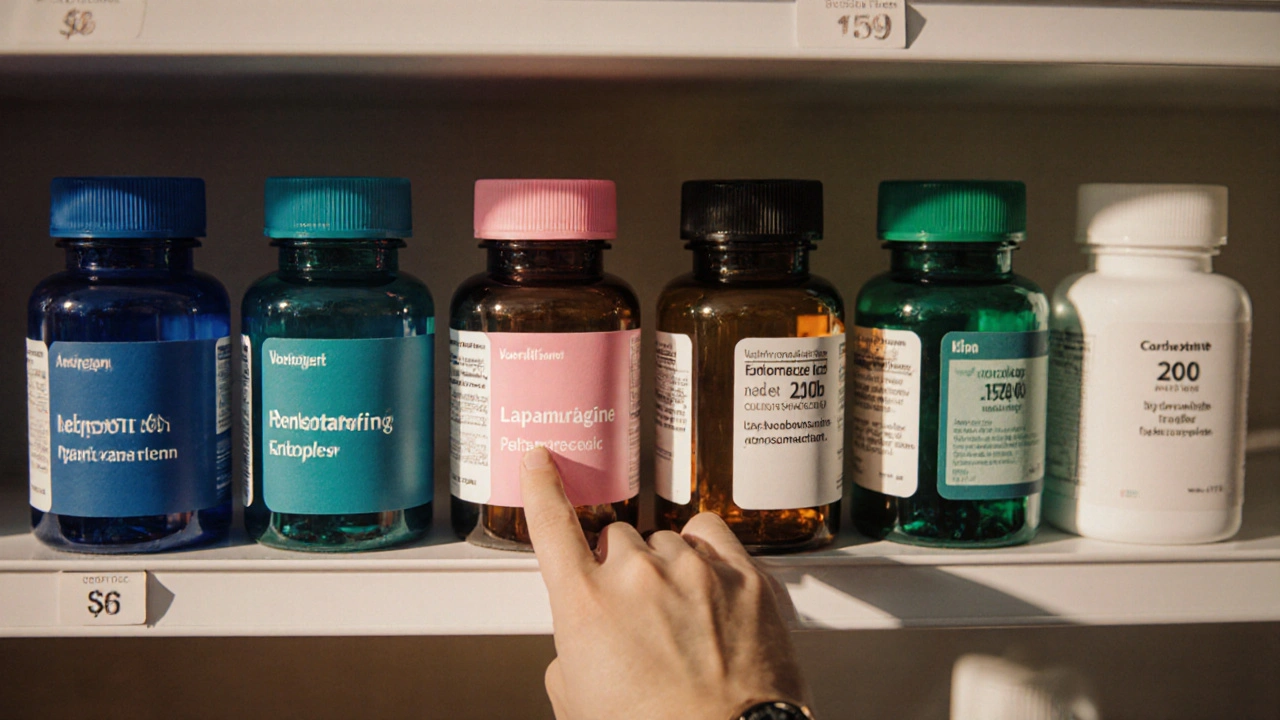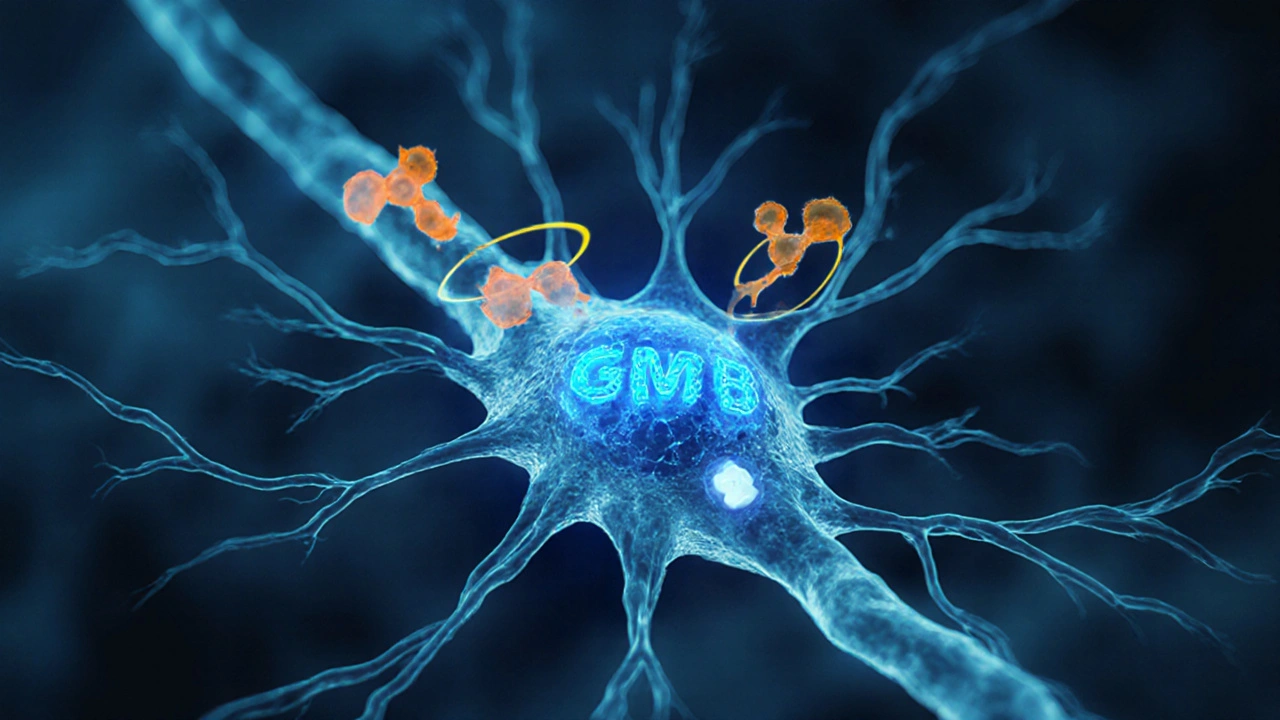Mysoline (Primidone) vs Alternatives Comparison Tool
- Mechanism of Action: How does the drug work in the brain?
- Effectiveness: Which seizure types is it best for?
- Side Effects: What are the common adverse reactions?
- Pregnancy Safety: Risk category for pregnant women
- Cost: Monthly cost range for generic versions
When doctors prescribe anti‑seizure drugs, Primidone is the generic name for Mysoline, a barbiturate‑derived medication that has been used for decades to control generalized tonic‑clonic seizures. It works by enhancing the activity of GABA, the brain’s main inhibitory neurotransmitter.
If you’ve been told to start Mysoline or you’re already on it, you probably wonder how it stacks up against newer options. Below we break down the most common alternatives, compare key factors such as effectiveness, side‑effect profile, cost, and give you a clear picture of when each drug might be a better fit.
How Primidone Works and Who It Helps Most
Primidone is metabolized into phenobarbital and phenylethylmalonamide (PEMA). Those metabolites boost GABA signaling, which calms hyper‑excitable neurons. Because of this dual‑action, Primidone is especially good for:
- Generalized tonic‑clonic seizures
- Essential tremor (often prescribed off‑label)
However, the drug can cause drowsiness, dizziness, and cognitive slowing, especially during the titration phase.
What to Look at When Comparing Anti‑Seizure Drugs
Every seizure medication has its own trade‑offs. Here are the five criteria we use to judge them:
- Mechanism of action - Does it target sodium channels, calcium channels, GABA, or something else?
- Effectiveness for seizure type - Some drugs are great for focal seizures but weak for generalized ones.
- Side‑effect profile - Cognitive impact, weight changes, mood issues, etc.
- Pregnancy safety - Crucial for women of child‑bearing age.
- Cost and availability - Generic pricing, insurance coverage, and pharmacy access.
Keeping these points in mind makes the comparison feel less like a maze and more like a checklist.
Quick Reference: How Primidone Stacks Up
| Drug | Mechanism | Best for | Common side effects | Pregnancy category | Typical monthly cost (US, generic) |
|---|---|---|---|---|---|
| Primidone | Barbiturate → GABA enhancement (via phenobarbital metabolite) | Generalized tonic‑clonic seizures, essential tremor | Drowsiness, dizziness, ataxia, cognitive slowing | C (risk cannot be ruled out) | $15-$30 |
| Levetiracetam | Modulates synaptic vesicle protein SV2A | Broad spectrum - focal & generalized | Irritability, fatigue, mood swings | C | $25-$45 |
| Valproic Acid | Increases GABA, blocks sodium channels | Generalized seizures, absence, myoclonic | Weight gain, hair loss, liver toxicity | D (contraindicated in pregnancy) | $10-$20 |
| Lamotrigine | Sodium‑channel blocker | Focal seizures, Lennox‑Gastaut syndrome | Rash (rare Stevens‑Johnson), dizziness | C | $20-$35 |
| Phenobarbital | Barbiturate → GABA potentiation | Generalized seizures, status epilepticus | Heavy sedation, dependence, cognitive decline | C | $5-$12 |
| Topiramate | Sodium‑channel blocker, carbonic anhydrase inhibition | Focal seizures, migraine prophylaxis | Kidney stones, weight loss, paresthesia | C | $30-$50 |
| Carbamazepine | Sodium‑channel blocker | Focal seizures, trigeminal neuralgia | Hyponatremia, rash, dizziness | C | $12-$25 |
| Oxcarbazepine | Sodium‑channel blocker (active metabolite of carbamazepine) | Focal seizures, adjunct for generalized | Hyponatremia, fatigue, diplopia | C | $15-$28 |

Deep Dive into the Top Alternatives
Levetiracetam (brand name Keppra) became popular because it works on a completely different pathway - the SV2A protein that helps regulate neurotransmitter release. Because it isn’t a sodium or calcium blocker, it doesn’t cause the typical “numb‑leg” feeling many older drugs do. The trade‑off? Around 15% of patients report mood irritability or aggression, especially during rapid dose increases.
Valproic Acid, known as Depakote, is a heavyweight in the seizure world. Its broad mechanism (both GABA boost and sodium‑channel block) makes it effective for many generalized seizure types, but the liver‑toxicity risk and severe birth‑defect warnings push it out of the first‑line slot for women who might become pregnant.
Lamotrigine (Lamictal) shines for focal seizures and certain childhood epilepsy syndromes. Its downside is a slow titration schedule - doctors often start at 25mg daily and double every one to two weeks to avoid a potentially life‑threatening rash. If you can wait, the cognitive side‑effects are mild compared with barbiturates.
Phenobarbital is essentially the parent molecule of Primidone. It’s cheap and potent, but the sedation and dependence risk are high. Most clinicians reserve it for cases where newer drugs have failed or for status epilepticus in emergency settings.
Topiramate (Topamax) adds a twist by inhibiting carbonic anhydrase, which can cause renal stones and a distinct tingling sensation in the hands. It’s a good fit for patients who also need migraine prevention, but the metabolic side‑effects make it less attractive for those with kidney concerns.
Carbamazepine has been a staple for focal seizures for decades. It can interact with many other drugs because it induces liver enzymes, which sometimes lowers the effectiveness of concurrent medications like oral contraceptives. Hyponatremia is another lab‑value red flag you’ll need to watch.
Oxcarbazepine was designed to reduce some of carbamazepine’s enzyme‑induction problems. It still carries a risk of hyponatremia, but the side‑effect profile is generally milder and the dosing schedule is simpler.
When Might You Switch From Primidone?
Here are common scenarios that push patients to consider a change:
- Excessive daytime sleepiness - If you’re still nodding off after weeks of titration, a non‑sedating drug like levetiracetam may help.
- Pregnancy planning - Switching to a category B drug (e.g., lamotrigine) before conception reduces fetal risk.
- Drug interactions - Primidone induces CYP3A4, which can lower levels of birth‑control pills or certain antiretrovirals. A drug with fewer enzyme effects, such as oxcarbazepine, can simplify the regimen.
- Cognitive concerns - If you notice memory fog, a switch to a medication with a lighter cognitive load, like topiramate (at low dose) or levetiracetam, is worth discussing.
Always taper Primidone slowly (often over 2-4 weeks) to avoid precipitating seizures. Your neurologist will map a step‑down schedule tailored to your current dose.
Cost and Insurance: What to Expect
Primidone’s generic price hovers around $15-$30 per month, making it one of the most affordable options. Levetiracetam, while still generic, tends to be a bit pricier at $25-$45. Valproic Acid and phenobarbital remain cheap (<$20), but their side‑effect management can add hidden costs (labs, specialist visits).
Most U.S. insurers cover the generics without prior authorization, but newer formulations or brand‑only versions may trigger a step‑therapy requirement. Checking your pharmacy’s discount program can shave another $5-$10 off the monthly bill.

Practical Tips for Managing Side Effects
- Start low, go slow - Gradual titration gives your brain time to adapt and reduces the likelihood of abrupt dizziness.
- Stay hydrated - Barbiturate‑based drugs can increase the risk of dehydration‑related headaches.
- Monitor labs - For drugs like carbamazepine, oxcarbazepine, and valproic acid, check sodium and liver enzymes every 3-6 months.
- Keep a symptom diary - Jot down any mood swings, rash, or new sensations. It helps your doctor fine‑tune the dosage or decide on a switch.
Bottom Line: Choosing the Right Seizure Medication
There’s no one‑size‑fits‑all answer. If you need a cheap, well‑tested drug for generalized seizures and can tolerate mild sedation, Primidone remains a solid choice. If you prioritize a lighter cognitive footprint or have pregnancy plans, alternatives like lamotrigine or levetiracetam often win.
Talk with your neurologist about the five comparison criteria listed earlier, factor in your lifestyle, and don’t forget to consider the hidden costs of side‑effect management. With the right information, you can move from “just coping” to a treatment plan that actually fits your life.
Frequently Asked Questions
Can I take Primidone and another anti‑seizure drug at the same time?
Yes, combination therapy is common, especially when a single drug doesn’t fully control seizures. Doctors often pair Primidone with a sodium‑channel blocker like lamotrigine to cover both generalized and focal types, but they’ll monitor blood levels closely.
How long does it take for Primidone to start working?
Therapeutic effects usually appear within 1-2 weeks of reaching a stable dose, but full seizure control may take up to a month as the drug and its metabolites accumulate.
Is Primidone safe for long‑term use?
Long‑term safety is well‑documented; the biggest concerns are chronic drowsiness, possible bone‑density reduction, and rare blood‑count changes. Regular check‑ups can catch issues early.
What should I do if I miss a Primidone dose?
Take the missed dose as soon as you remember, unless it’s almost time for the next dose. In that case, skip the missed one and continue your regular schedule - don’t double up.
Can Primidone cause weight gain?
Weight gain isn’t a primary side effect, but some people notice a modest increase due to reduced seizure activity and a slight appetite boost. Monitoring diet and activity helps keep it in check.


John Keough
October 7, 2025 AT 14:01Primidone’s GABA‑enhancing action can be a double‑edged sword; it’s great for damping the hyper‑excitable networks that cause tonic‑clonic seizures, yet the same mechanism often drags people into a fog of drowsiness. In my experience, the sedative effect is most pronounced during the first few weeks of titration, when the body is still adjusting to the phenobarbital metabolite. If you notice that you’re nodding off during the day, a modest dose reduction or splitting the dose into two administrations can help smooth out the peaks. Another practical tip is to avoid alcohol, as it can amplify the CNS depression and increase fall risk. Many patients also report a subtle cognitive slowdown, especially with tasks that require rapid mental shifts. That’s why some clinicians schedule a neuropsych evaluation after the patient stabilizes on a steady dose. On the plus side, the cost of generic primidone is very friendly to most insurance plans, usually hovering between fifteen and thirty dollars a month. For those who are cost‑sensitive, it remains one of the most affordable options on the market. When comparing to newer agents like levetiracetam, remember that primidone is metabolized by CYP enzymes, so drug‑drug interactions can be a consideration if you’re on multiple meds. Overall, it’s a solid choice for generalized tonic‑clonic seizures, especially when you keep an eye on dosing and side‑effects.
Graham Smith
October 19, 2025 AT 03:47Primidone can cause dizzyness if not tapered correctly.
Jeremiah Morgan
October 30, 2025 AT 17:34Allow me to extend my gratitude for the comprehensive synthesis presented herein; it behooves us, as members of the neurological community, to recognize the nuanced interplay between pharmacodynamics and patient‑centred outcomes. Primidone, a venerable barbiturate derivative, leverages the augmentation of GABA‑ergic inhibition via its phenobarbital metabolite, thereby attenuating the hyper‑synchrony that typifies generalized tonic‑clonic events. Its efficacy, however, must be weighed against the spectrum of adverse effects, which include somnolence, ataxia, and a measurable decrement in psychomotor speed. In clinical practice, I have observed that a slow titration schedule-incrementally increasing by twenty‑five milligrams weekly-mitigates the abrupt onset of these side‑effects. Moreover, the economic considerations cannot be overstated: a monthly cost bracket of fifteen to thirty dollars renders primidone exquisitely accessible to a broad demographic, particularly those burdened by high‑deductible health plans. Nonetheless, the pharmacokinetic profile warrants vigilance; it induces cytochrome P450 enzymes, potentially diminishing plasma concentrations of concurrent therapies such as oral contraceptives. When juxtaposed with contemporary agents like levetiracetam, which modulates SV2A without notable enzyme induction, the decision matrix expands beyond mere seizure control to encompass drug‑interaction paradigms and quality‑of‑life metrics.
In scenarios wherein a patient anticipates pregnancy, the category C designation of primidone suggests a cautious approach, favouring agents with a robust safety record in gestation, such as lamotrigine, provided seizure control remains uncompromised. Ultimately, the stewardship of antiepileptic therapy is a dynamic process, demanding periodic reassessment of efficacy, tolerability, and socioeconomic impact, all whilst maintaining an unwavering commitment to patient safety and therapeutic autonomy.
nina greer
November 11, 2025 AT 07:21The table is excellently formatted; it conveys essential data succinctly.
Montague Tilmen
November 22, 2025 AT 21:07Honestly, these fancy new drugs are just a way for pharma to overprice what primidone already does for free; stop falling for the hype!
Clarise Wheller
December 4, 2025 AT 10:54I really appreciate how this post breaks down each medication side‑by‑side; it makes the decision process far less intimidating for patients and families alike. Thanks for the clear layout and the practical tips on tapering!